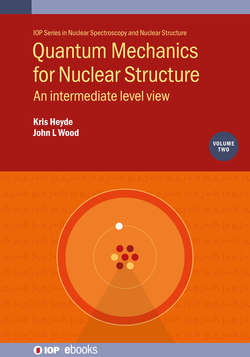Читать книгу Quantum Mechanics for Nuclear Structure, Volume 2 - Professor Kris Heyde - Страница 24
На сайте Литреса книга снята с продажи.
1.16 Spin-12 particles; neutron interferometry
ОглавлениеThe constituents of matter—electrons, protons, and neutrons—all have intrinsic spin of 12ℏ. ‘Intrinsic’ is the term coined to convey the fact that the dynamics of spin does not occur in physical space. ‘Spin space’ is not accessible to the physicist in the sense that the spin of a particle cannot be changed: it is intrinsic to the particle. In fact, it is not known what spin is. It is only known what spin does, namely ‘couple’ to other spins and angular momenta such that it behaves as a j=12 representation of SU(2).
In the absence of other particles and when its own angular momentum is zero, the quantum mechanics of a spin-12 particle is almost trivial. It can exist in two possible states: ‘spin up’ and ‘spin down’. These are directional components of the spin vector and are usually defined by
sˆzs=12,ms=±12=±12ℏs=12,ms=±12,(1.261)
where the direction is defined to be the z-axis in (3,R). However, there is one extraordinary property of spin-12 particles: a rotation through 2π does not leave their state kets unchanged! This is seen immediately from equation (1.52) for ϕ=2π, whence (using ∣sms〉↔χ±)
D12(nˆ,2π)χ±=Iˆcosπ−iσ⃗·nˆsinπχ±,(1.262)
∴D12(nˆ,2π)χ±=−χ±.(1.263)
This property is not observable where expectation values are involved; but it has a dramatic effect on the interferometry of beams of spin-12 particles.
The interferometry (diffractive splitting and recombination) of particle beams is a well-established property of quantum mechanical particles. It is most elegantly illustrated using beams of neutrons. Neutrons, being electrically neutral, are not subject to stray electric fields which can obscure the interferometric properties of electrically charged particles. However, neutrons have magnetic moments and through the use of suitable magnetic fields it is possible to effect the rotation of the state of a neutron. This has been done using the experimental arrangement shown schematically in figure 1.2. A picture of the silicon crystal, which is the essential component of the interferometer is shown in figure 1.3. The neutron beam is divided and recombined in such a way that one part passes through a magnetic field B which causes the neutron state ket to undergo a phase change. The recombined beam exhibits an interference pattern which can be varied by changing B. Some results are shown in figure 1.4. (Note: by ‘divided’ it is meant that for each individual neutron, it is not certain which path it takes. It is not a situation where some neutrons take one path and the other neutrons take the other path.)
Figure 1.2. A schematic diagram of the paths of a beam of neutrons through the neutron interferometer shown in figure 1.3. The lattice planes are continuous from slab to slab and the distances a, d1, and d2 are machined to optical precision. The phase shift (state ket rotation) is effected in the darkened region using a magnetic field. The distances d1 and d2 are typically 3 cm and a is typically 0.5 cm.
Figure 1.3. The essential component of the neutron interferometer in use at the University of Missouri. It consists of three silicon slabs machined from a single crystal of high-purity silicon to ensure alignment of crystal planes from slab to slab. (Reproduced from [1], with the permission of the American Institute of Physics.)
Figure 1.4. Observed neutron intensities in counts/2 min in the O beam and H beam, i.e. in counters C3 and C2, respectively, in figure 1.2. This is effected by changing the magnetic field action (given in Gauss cm) on the neutron beam by varying the magnet current (given in milliamps). One oscillation corresponds to a rotation of 4π not 2π. (Reprinted from [2], Copyright (1975), with permission from Elsevier.)
The phase change produced by the magnetic field is eiωT2, where T is the time spent by the neutrons in the magnetic field, ω is the spin-precession frequency,
ω=2μnBℏ,(1.264)
μn is the magnetic moment of the neutron, and the magnetic field is assumed to be of uniform constant strength B. The phase change is the standard result for a magnetic field B acting for a time T on a magnetic moment μn, causing the spin to precess. The connection between precession and rotation is seen to follow directly from the Hamiltonian for a neutron in the magnetic field (chosen to be in the z direction)
Hˆ=ωSˆz,(1.265)
the time evolution operator for the system
U(t,0)=exp−iHˆtℏ=exp−iSˆzωtℏ,(1.266)
and a comparison with the rotation operator about the z-axis
Dz(ϕ)=exp−iSˆzϕℏ,(1.267)
i.e.
ϕ=ωt.(1.268)
For a monoenergetic beam of neutrons, T is fixed. To produce the results shown in figure 1.4, B is varied (by varying the current to the magnet). The change in B necessary to yield successive maxima is given by
ΔB=ℏ2μnλmd,(1.269)
where λ is the de Broglie wavelength of the neutrons, m is the neutron mass, and d is the length of the path for which B≠0.
The extraordinary property of the states of spin-12 particles, that they must be rotated through 4π to ‘bring them back to their unchanged orientation’, does not parallel our experience of rotating everyday objects. Such states are called spinors.
